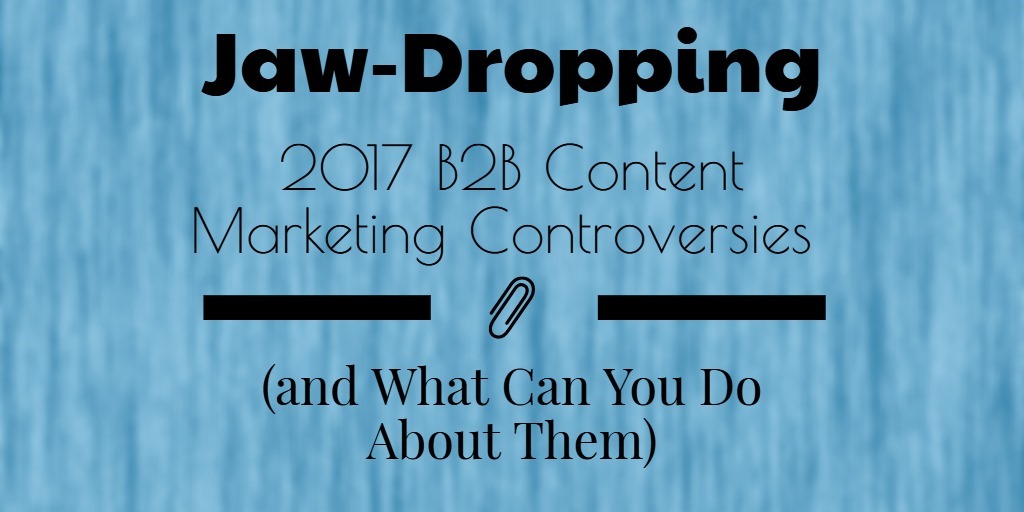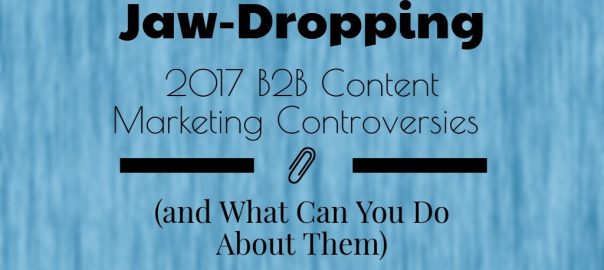
“If utopian fiction became the new trend, I wouldn’t read it.” – Veronica Roth
It’s that time of a year again…The internet is showered with experts claiming that they have nailed 2017 content marketing trends, predictions, benchmarks …you name it.
By the end of 2015, after immersing myself in the next-year-predictions avalanche, I wrote a comprehensive article as a sincere attempt to help B2B content marketers save their ROI sanity in 2016.
This year is no exception. While I highly recommend that you, as an up-to-date B2B marketer, take a close look at a rich variety of content marketing trends and resources, it’s vital that you measure them against your unique business objectives. In some cases, ignoring trends all together is the best way to go. In other cases, the opposite is true. Where does your business fit within the ever-changing
Where does your business fit within the ever-changing hot trends spectrum?
What if you stumbled upon highly controversial (and even contradicting) content marketing predictions? How can you CONFIDENTLY determine your next move?
Part 1: Opposite-extremes Content Marketing Trends For 2017
Before we kick off our exciting journey, I must acknowledge Content Marketing Institute (CMI) for being my number one go-to place for reliable content marketing trends and statistics.
I discovered some highly controversial and opposite extremes content marketing trends within their must-read e-book 60+ Content Marketing Predictions for a Successful 2017
I will examine them closely and offer commonsense guidelines to help you determine how YOUR business can leverage them for optimal ROI.
In addition, I will be referring to some important stats from their invaluable study B2B Content Marketing 2017 Benchmarks, Budgets and Trends – North America.
The Future Of Blogging In 2017: “Blogs Will Shut Down” Vs “Blog Blog Blog!”
Mike Stelzner, CEO and Founder of Social Media Examiner, predicts the death of blogging in 2017.
“…Facebook will decide what consumers see online. Google will serve up only that content that complies with its rules and is housed on its servers. Email solutions like Gmail and Yahoo will tighten their own algorithms, as well; so the content creator’s ability to reach the inbox may be at risk… Traffic to websites will decline, and blogs will shut down. Gone will be the days of unrestricted information flow and true information freedom. The future will only be more controlled, more filtered, and less open.” (Page 21)
On the other end of the spectrum, Heidi Cohen, Chief Content Officer at Actionable Marketing Guide, begs to differ!
“…Place your blog at the core of your owned media to drive email acquisition, leads, and revenues.” (Page 50)
My Take on The “To Blog or Not to Blog” Predictions
While Mike is offering very logical insights, I believe that his bold claim that blogs will “shut down” in 2017 is an exaggeration. Should you take his word for it or go for Heidi’s recommendation?
While these two predictions sound contradicting, many experts in the same CMI e-book unanimously agreed on the importance of crafting a comprehensive content distribution strategy in 2017.
Ideally, your content distribution plan should consist of a balanced mix of owned, earned and paid media, not to mention intelligent influencer marketing tactics.
To make the best of both worlds, think of your blog as your digital asset that you constantly need to nurture with quality content. In the meantime, integrate the big social media players into your overall content distribution strategy.
You may refer to the following stat for a healthy dose of inspiration.

Content Marketing or Paid Advertising? Can You Possibly Mix Both?
Travis Wright, Cofounder, Chief Marketing Technologist at CCP.Digital, advocates adding paid Ads to your content marketing mix:
“Last year, according to a report by Beckon, enterprise content creation increased by 300%, yet less than 5% of that content had 10 or more shares! Some corporate content is so bad, that the employees won’t even share it.
As a result of poor organic reach of content, we’ve been seeing a rise in content advertising and paid content amplification. Not only with channels like Taboola or Outbrain, but also on Facebook, Twitter, LinkedIn, YouTube, and many others. I’m advising my clients to devote a portion of their ad spend to amplifying content to highly targeted audiences…” (Page 6)
While Travis makes a sound argument, Julie Fleischer, the Managing Director at OMD, referred to the latest U.S. presidential elections to prove him wrong!
“If there is anything we learned in the election of 2016, it’s the ascendancy of marketing over advertising. People want authentic voices in channels they choose, not canned messages in contexts they don’t. Content marketing will become even more important for connecting people to ideas and values…” (Page 16)
My Take on The “Content Marketing Versus Paid Ads” Predictions
Your budget should be deciding factor here. Paid ads, especially social media advertising, have been proven to yield massive ROI when targeted effectively.
However, before going for paid content amplification, your number one priority should be creating quality content that’s worth promoting. Then (and only then), you may leverage paid advertising to promote your best content.
The following stat provides a helpful guideline for preferred B2B content promotion channels.

“Less Is More” Versus Producing “Tons” of Content!
Frank Strong, founder and president of Sword and the Script Media, strongly advocates the “less is more” approach for content marketing in 2017.
“…Successful organizations will reduce their content volume in favor of producing fewer but more thorough and lengthy pieces. Many will jettison the click addiction in favor of trust as a means of measurement.” (page 59)
On the other hand, Amanda Todorovich, Content Marketing Director at Cleveland Clinic, believes that 2017 will witness tons of content creation.
“Brand marketers will continue to create tons of content. It’s just where we are right now; however, I think more brands will start to realize distribution is equally critical…” (Page 4)
According to the following stat, 70% of surveyed B2B content marketers agree with her as they plan to produce more content in 2017.

My Take on the Opposite Content Volume Predictions
My personal no-brainer recommendation is that you should NEVER compromise quality. If you can produce tons of quality content, then go for it by all means. If not, then definitely outstanding but scarce content production is your best bet. (I will explain the exact meaning of “quality content” below within my absolute favorite content marketing prediction for 2017.)
Again and again, (I’m repeating this point because it’s worth repetition) dedicate enough time to plan, execute and measure the right content distribution strategy for your business. A content marketing analytics template can be extremely helpful in that regard.
Part 2: Unarguably Sound Content Marketing Predictions For 2017
Interactive Content, Interactive Content and Interactive Content!
Scott Brinker, co-founder of ion interactive, predicts that 2017 will witness more emphasis on interactive content.
“Content marketing will continue to expand beyond static assets that people passively consume, and will move more towards dynamic content that incorporates interactive participation. More brand marketers will experiment with interactive content – quizzes, assessments, calculators, solution finders, etc…” (page 5)
The following stat offers invaluable insights that showcase the most effective types of interactive content to incorporate within the various stages of the buyer’s journey.

The Internet of Things, Context, Personalization and More…
Rebecca Lieb, Analyst, Author, Advisor at Conglomotron LLC, believes that context backed up by technology is a hot content marketing trend for 2017.
“Context will be the foundation of the next phase of content marketing. Brands will develop highly contextual content that goes beyond the screen into the “phygital” world, enabled by beacons, sensors and the Internet of Things. They will develop methods for making highly personalized and relevant real-time messages based on triggers such as purchase history, the weather, physical location, and myriad more factors. Such campaigns are highly complex and technically demanding, but as one Disney executive once told me, ‘The more context there is, the higher the ROI.’ ” (Page 13)
Non-fiction Storytelling And Live Video
Jay Baer, one of my favorite go-to experts and the president of Convince & Convert, advocates mastering non-fiction storytelling in 2017.
“In 2017, content marketers will focus on non-fiction, not fiction. Millennials abhor falsehoods; as they become the dominant audience, storytelling will become grounded in reality. In addition, the rise of live video (a cause and effect of the non-fiction shift) will require brands to use documentary-style communication, warts and all.” (Page 27)
For more of Jay Baer’s must-read insights, I highly recommend his article The 7 Content Marketing Trends That Matter in 2017
Ready For The 2017’S Cognitive Content Revolution?
Scott Abel, CEO of The Content Wrangler, believes that 2017 will witness the rise of intelligent content.
“…The move to intelligent marketing content is imperative. The coming “cognitive content revolution” – powered by natural language processing, pattern matching, and machine learning technologies – will usher in a new era of computing…” (Page 20)
Incorporate Virtual Reality Content for Optimal User Experience
Tim Riesterer, Chief Strategy Officer at Corporate Visions, believes that virtual reality (VR) will become a big player for content marketing in 2017.
“Brand marketers will begin to explore the possibilities of virtual reality content to connect with their prospects and customers. VR provides a truly unique content marketing experience and, as such, can achieve higher levels of consumer engagement. Marriott, Lexus, and IKEA successfully used VR for 2016 campaigns. So, who is next?” (Page 41)
Part 3: The Coolest 2017 Predictions and My Absolute Favorite One
Second Runner Up For The Coolest 2017 Predictions: Google Will Buy Twitter…
Andy Crestodina, co-founder and strategic director at Orbit Media, claims that Twitter will become the second YouTube…Who can ever stop Google’s appetite for acquisition?
“Google will buy Twitter for tens of billions of dollars. They won’t change Twitter much, but there will be more ads. The ROI for buying advertising in Twitter will go up.” (Source: iAnalyst)
That’s an interesting prediction to watch out for. It makes sense to me. How about you?
The Coolest 2017 Digital Marketing Prediction: Can Google and Facebook Possibly Coexist?
Doug Kessler, Creative director at Velocity Partners, came up with a brilliant assumption.
“…Google and Facebook will buy each other (for fun)…” (Source: Marketing Insider Group)
As refreshingly funny and unrealistic this prediction may sound, one can’t help but wonder how the two digital marketing giants can possibly coexist! Let’s wait and see…
My Absolute Favorite Content Marketing Prediction In 2017: Quality Content Defined
My absolute favorite 2017 content marketing prediction comes from Jason Miller – Content & Social Media Marketing Leader at LinkedIn Marketing Solutions.
“Micro-targeting and hyper personalization will go mainstream. (Smaller audiences + more relevant messaging = higher conversion rate)” (Source: Marketing Insider Group)
I love this prediction because it’s profoundly brief and to-the-point.
Interestingly, this prediction is not a trend! It’s a timeless, old-school marketing principle that advocates narrowing your target market down to smaller segments to ensure unifying your marketing messages to them.
In my absolute favorite blog post of all time, Memories of A Content Marketing Guru ,I warned against businesses that narrow their niche market down to one word: Everyone!
In 2017, adopting this ancient marketing concept is no longer a nice-to-do practice. It’s a PRIORITY.
Simply put: In order to generate massive content marketing ROI in 2017, you must nail Micro-targeting and hyper personalization. Period!
A Final Word of Advice
STOP chasing after hot trends until you get your content marketing priorities straight. Take my word for it: There will always be a new technology or tool out there promising to be the best business solution that ever existed.
“The only constant thing is change.” That’s a very accurate statement but I may also add that the only constant goal is your ongoing need to offer your eager audience superior content. If you do, you may become a trendsetter rather than a trend follower.
I can’t wait to read your take on the above B2B content marketing trends for 2017 in the comments. Your valuable contribution is much appreciated. To your success!
Hand-Picked Related Articles:
- The Difference Between Marketing And Growth Hacking
- Content Marketing Best Practices
- 5 Content Marketing Trends That Will Change SEO In 2017
* Adapted lead image: ![]() Public Domain, pixabay.com via getstencil.com
Public Domain, pixabay.com via getstencil.com
Jaw-Dropping 2017 B2B Content Marketing Controversies (and What Can You Do About Them) [Stats]
The post Jaw-Dropping 2017 B2B Content Marketing Controversies (and What Can You Do About Them) [Stats] appeared first on Search Engine People Blog.
Search Engine People Blog(27)






